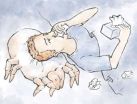(Press-News.org) If you're allergic to dust mites (and chances are you are), help may be on the way.
Researchers at the University of Iowa have developed a vaccine that can combat dust-mite allergies by naturally switching the body's immune response. In animal tests, the nano-sized vaccine package lowered lung inflammation by 83 percent despite repeated exposure to the allergens, according to the paper, published in the AAPS (American Association of Pharmaceutical Scientists) Journal. One big reason why it works, the researchers contend, is because the vaccine package contains a booster that alters the body's inflammatory response to dust-mite allergens.
"What is new about this is we have developed a vaccine against dust-mite allergens that hasn't been used before," says Aliasger Salem, professor in pharmaceutical sciences at the UI and a corresponding author on the paper.
Dust mites are ubiquitous, microscopic buggers who burrow in mattresses, sofas, and other homey spots. They are found in 84 percent of households in the United States, according to a published, national survey. Preying on skin cells on the body, the mites trigger allergies and breathing difficulties among 45 percent of those who suffer from asthma, according to some studies. Prolonged exposure can cause lung damage.
Treatment is limited to getting temporary relief from inhalers or undergoing regular exposure to build up tolerance, which is long term and holds no guarantee of success.
"Our research explores a novel approach to treating mite allergy in which specially-encapsulated miniscule particles are administered with sequences of bacterial DNA that direct the immune system to suppress allergic immune responses," says Peter Thorne, public health professor at the UI and a contributing author on the paper. "This work suggests a way forward to alleviate mite-induced asthma in allergy sufferers."
The UI-developed vaccine takes advantage of the body's natural inclination to defend itself against foreign bodies. A key to the formula lies in the use of an adjuvant—which boosts the potency of the vaccine—called CpG. The booster has been used successfully in cancer vaccines but never had been tested as a vaccine for dust-mite allergies. Put broadly, CpG sets off a fire alarm within the body, springing immune cells into action. Those immune cells absorb the CpG and dispose of it.
This is important, because as the immune cells absorb CpG, they're also taking in the vaccine, which has been added to the package, much like your mother may have wrapped a bitter pill around something tasty to get you to swallow it. In another twist, combining the antigen (the vaccine) and CpG causes the body to change its immune response, producing antibodies that dampen the damaging health effects dust-mite allergens generally cause.
In lab tests, the CpG-antigen package, at 300 nanometers in size, was absorbed 90 percent of the time by immune cells, the UI-led team reports. The researchers followed up those experiments by giving the package to mice and exposing the animals to dust-mite allergens every other day for nine days total. In analyses conducted at the UI College of Public Health, packages with CpG yielded greater production of the desirable antibodies, while lung inflammation was lower than particles that did not contain CpG, the researchers report.
"This is exactly what we were hoping for," says Salem, whose primary appointment is in the College of Pharmacy.
The researchers will continue to test the vaccine in the hope that it can eventually be used to treat patients.
INFORMATION:
The paper's first author is Vijaya Joshi, a graduate fellow in pharmacy at the UI. Contributing authors, all from the UI, include Andrea Dodd, Xuefang Jing, Amaraporn Wongrakpanich and Katherine Gibson-Corley.
The National Institutes of Health (grant numbers: P30 ES005605, R21 CA1 13345-01, R21 CA1 28414-01), the American Cancer Society and the UI's Lyle and Sharon Bighley professorship funded the research.
Researchers create vaccine for dust-mite allergies
Vaccine reduced lung inflammation to allergens in lab and animal tests
2014-07-22
ELSE PRESS RELEASES FROM THIS DATE:
Activity level may predict orthopedic outcomes
2014-07-22
According to a literature review in the July issue of the Journal of the American Academy of Orthopaedic Surgeons (JAAOS), patients' activity level is a strong predictor for how well they will do with certain treatments and how well they recover from injuries after treatment. Patients are encouraged to ask their orthopaedic surgeon if activity level is an important factor in their treatment decision. For example, more active patients are at a higher risk of re-injury after an anterior cruciate ligament (ACL) reconstruction, and activity level should be considered when deciding ...
UI study finds potential genetic link between epilepsy and neurodegenerative disorders
2014-07-22
A recent scientific discovery showed that mutations in prickle genes cause epilepsy, which in humans is a brain disorder characterized by repeated seizures over time. However, the mechanism responsible for generating prickle-associated seizures was unknown.
A new University of Iowa study, published online July 14 in the Proceedings of the National Academy of Sciences, reveals a novel pathway in the pathophysiology of epilepsy. UI researchers have identified the basic cellular mechanism that goes awry in prickle mutant flies, leading to the epilepsy-like seizures.
"This ...
Death of a parent during childhood is associated with greater mortality in early adulthood
2014-07-22
Experiencing the loss of a parent during childhood or adolescence is associated with a greater risk of mortality, according to a study published in this week's PLOS Medicine. The study, conducted by Jiong Li and colleagues from Aarhus University in Denmark, finds that individuals who lost either a mother or a father during childhood had a greater risk of mortality in the years following the parent's death compared with people unaffected by parental death during childhood.
The researchers reached these conclusions combining data from national registries from all children ...
Distinctive developmental origin for a drainage tube in the eye
2014-07-22
A Jackson Laboratory based research team has conducted a comprehensive exploration of an eye structure known as Schlemm's canal: a key gatekeeper for the proper flow of eye fluid, presenting a number of insights relevant to glaucoma and other diseases.
For the study publishing July 22 in the Open Access journal PLOS Biology, the researchers at JAX and Tufts University School of Medicine in Boston developed a new, "whole-mount," three-dimensional approach to analyse mouse models that have been engineered to host fluorescent proteins, to determine how Schlemm's canal forms ...
New research finds pathogenic connection between autoimmune disorders and cancer
2014-07-22
WASHINGTON -- Autoimmune disorders may share certain pathogenic mechanisms with cancer, according to a new report by George Washington University (GW) researcher Linda Kusner, Ph.D., published in PLOS ONE on July 22.
This paradigm shifting work shows that the very same inhibitors of apoptosis, or cell destruction, in tumors are also expressed in cells that produce autoimmune diseases. Henry Kaminski, M.D., chair of the Department of Neurology at the GW School of Medicine and Health Sciences (SMHS), as well as colleagues from the Roswell Park Cancer Institute, collaborated ...
NASA provides double vision on Typhoon Matmo
2014-07-22
Two instruments aboard NASA's Aqua satellite provided different views of Typhoon Matmo on its approach to Taiwan today, July 22.
The Moderate Resolution Imaging Spectroradiometer or MODIS instrument snapped a visible picture of Typhoon Matmo's clouds on July 22 at 1:10 a.m. EDT. The MODIS image showed a center obscured by clouds. Bands of thunderstorms wrapped tightly into the center of circulation, creating the signature comma shape of a mature tropical cyclone. At the time of the image, the center was southeast of the southeastern tip of Taiwan. The image also showed ...
Carlton Fire Complex, Washington -- July 22, 2014
2014-07-22
The Carlton Complex fires started on July 14, 2014, by lightning from a weather system that moved through the Methow Valley. The Carlton Complex consists of four fires: Stokes Fire, Gold Hikes Fire, French Creek Fire and the Cougar Flat. The Stokes and Gold Hikes fires are now one larger fire. The fires are burning in timber and grass and the area burning is currently over 243,000 acres in size. The present fire situation continues to rapidly change due to the high fire danger. Public and firefighter safety is the priority on the Carlton Complex fires. Thirty-five primary ...
African elephant genome suggests they are superior smellers
2014-07-22
July 22, 2014 – Sense of smell is critical for survival in many mammals. The ability to distinguish different odors, which is important for sniffing out food, avoiding predators, and finding mates, depends on the number and type olfactory receptors found in an organism's genome. In a study published today in Genome Research, researchers examined the olfactory receptor (OR) repertoire encoded in 13 mammalian species and found that African elephants have the largest number of OR genes ever characterized; more than twice that found in dogs, and five times more than in humans.
To ...
High-salt diet doubles threat of cardiovascular disease in people with diabetes
2014-07-22
Washington, DC -- People with Type 2 diabetes who eat a diet high in salt face twice the risk of developing cardiovascular disease as those who consume less sodium, according to a new study published in the Endocrine Society's Journal of Clinical Endocrinology & Metabolism.
Diabetes occurs when there is too much sugar in the bloodstream. People develop Type 2 diabetes when their bodies become resistant to the hormone insulin, which carries sugar from the blood to cells.
According to the U.S. Centers for Disease Control and Prevention, about 29.1 million Americans ...
Vitamin D deficiency raises risk of schizophrenia diagnosis
2014-07-22
Washington, DC -- Vitamin D-deficient individuals are twice as likely to be diagnosed with schizophrenia as people who have sufficient levels of the vitamin, according to a new study published in the Endocrine Society's Journal of Clinical Endocrinology & Metabolism.
Vitamin D helps the body absorb calcium and is needed for bone and muscle health. The skin naturally produces this vitamin after exposure to sunlight. People also obtain smaller amounts of the vitamin through foods, such as milk fortified with vitamin D. More than 1 billion people worldwide are estimated ...
LAST 30 PRESS RELEASES:
Numbers in our sights affect how we perceive space
SIMJ announces global collaborative book project in commemoration of its 75th anniversary
Air pollution exposure and birth weight
Obstructive sleep apnea risk and mental health conditions among older adults
How talking slows eye movements behind the wheel
The Ceramic Society of Japan’s Oxoate Ceramics Research Association launches new international book project
Heart-brain connection: international study reveals the role of the vagus nerve in keeping the heart young
Researchers identify Rb1 as a predictive biomarker for a new therapeutic strategy in some breast cancers
Survey reveals ethical gaps slowing AI adoption in pediatric surgery
Stimulant ADHD medications work differently than thought
AI overestimates how smart people are, according to HSE economists
HSE researchers create genome-wide map of quadruplexes
Scientists boost cell "powerhouses" to burn more calories
Automatic label checking: The missing step in making reliable medical AI
Low daily alcohol intake linked to 50% heightened mouth cancer risk in India
American Meteorological Society announces Rick Spinrad as 2026 President-Elect
Biomass-based carbon capture spotlighted in newly released global climate webinar recording
Illuminating invisible nano pollutants: advanced bioimaging tracks the full journey of emerging nanoscale contaminants in living systems
How does age affect recovery from spinal cord injury?
Novel AI tool offers prognosis for patients with head and neck cancer
Fathers’ microplastic exposure tied to their children’s metabolic problems
Research validates laboratory model for studying high-grade serous ovarian cancer
SIR 2026 delivers transformative breakthroughs in minimally invasive medicine to improve patient care
Stem Cell Reports most downloaded papers of 2025 highlight the breadth and impact of stem cell research
Oxford-led study estimates NHS spends around 3% of its primary and secondary care budget on the health impacts of heat and cold in England
A researcher’s long quest leads to a smart composite breakthrough
Urban wild bees act as “microbial sensors” of city health.
New study finds where you live affects recovery after a hip fracture
Forecasting the impact of fully automated vehicle adoption on US road traffic injuries
Alcohol-related hospitalizations from 2016 to 2022
[Press-News.org] Researchers create vaccine for dust-mite allergiesVaccine reduced lung inflammation to allergens in lab and animal tests



